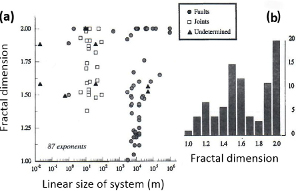| |||||||
|
|
|||||||
|
|
|||||||
| Geostatistical Properties of Multiple Fault Sets | |||||||
|
In many cases, geostatistical properties of multiple sets of joints, shear bands and faults are dealt together particularly for faults formed by shearing of joints and joint zones. Attempts have been made by some investigators to distinguish between these different modes of fractures and their distributions (Myers, 1999; Davatzes and Aydin, 2003a; b; Flodin and Aydin, 2004; and de Joussineau and Aydin, 2007) provide scanline data in which fracture modes are identified and their lengths and spacing properties were analyzed separately. One of the most comprehensive treatment of the subject of multisets of fractures by Bonnet et al. (2001) who attempted to distinguish between data for joints and faults and their fractal dimensions and linear sizes (Figure 1). The authors highlighted several issues such as band-width of observation (sampling and truncation effects); nonfractal scaling; clustering; orientation (fracture anisotropy); dimension of observation; and fracture types (joints versus faults). The plots show common fractal dimensions between 1.5 to 2.0. The major difference is in the linear sizes of the joint and fault systems, the latter of which is of interest here. Obviously the fault systems have larger linear sizes. The authors highlighted several issues such as band-width of observation (sampling and truncation effects); nonfractal scaling; clustering; orientation (fracture anisotropy); dimension of observation; and fracture types (joints versus faults). | |||||||
| Reference: |
|||||||
| Bonnet, E., Bour, O., Odling, N. E., Davy, P., Main, I., Cowie, P.A., Berkowitz, B., 2001 Davatzes, N.C., Aydin, A., 2003 Davatzes, N.C., Aydin, A., 2003 de Joussineau, G., Aydin, A., 2007 Flodin, E.A., Aydin, A., 2004 Myers, R., 1999 |
|||||||
|
Readme | About Us | Acknowledgement | How to Cite | Terms of Use | Ⓒ Rock Fracture Knowledgebase |
|||||||
